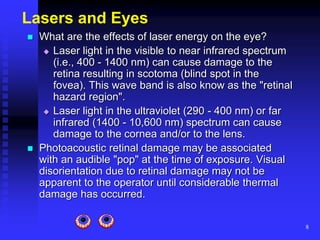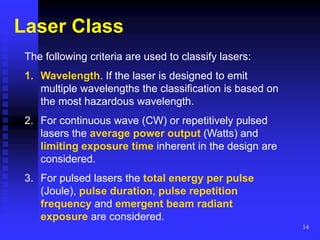The document provides an overview of laser safety fundamentals including:
- The properties that make laser light hazardous including being monochromatic, coherent, and highly directional.
- Common laser types categorized by wavelength output.
- Laser output characteristics such as continuous wave vs pulsed output.
- Types of laser hazards including those to the eye, skin, and from electrical and chemical sources.
- Symptoms of laser eye injuries and classifications of lasers based on their hazard potential outlined in safety standards.
- Control measures like engineering controls, administrative procedures, and personal protective equipment including laser safety eyewear.


















![19
Hazard Terms
Maximum Permissible Exposure (MPE)
The MPE is defined in ANSI Z-136.1"The level of laser radiation to
which a person may be exposed without hazardous effect or adverse
biological changes in the eye or skin."
The MPE is not a distinct line between safe and hazardous exposures.
Instead they are general maximum levels, to which various experts
agree should be occupationally safe for repeated exposures.
The MPE, expressed in [J/cm^2] or [W/cm^2], depends on the laser
parameters:
• wavelength,
• exposure duration,
• pulse Repetition Frequency (PRF),
• nature of the exposure (specular, diffuse reflection).](https://image.slidesharecdn.com/laserssafety-240202152345-56528b7a/85/LASERSsafety-ppt-19-320.jpg)





